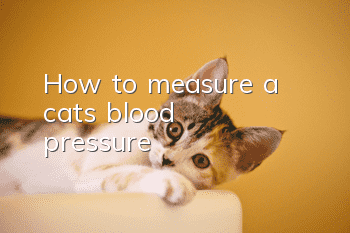How to measure a cat’s blood pressure?

The blood pressure of cats is also an indicator that our owners need to pay attention to at all times. Blood pressure is an important vital sign of animals. During first aid and surgery, changes in blood pressure should be monitored at any time to maintain stable blood pressure. At the same time, hypertension is the most common cardiovascular disease in daily disease diagnosis. To a certain extent, high blood pressure in pets is as important as in us humans. Pets do not smoke, do not have to worry about buying a house due to the increasing housing prices, and they do not consume excessive cholesterol. Unfortunately, they can also suffer from high blood pressure.
1. The significance of blood pressure measurement
Blood pressure refers to the lateral pressure caused by blood on the blood vessel wall, which depends on the pumping volume of the heart, heart rate, resistance of arterioles to blood flow, elasticity of the aorta, circulating blood volume, and blood concentration and viscosity sex. So what is high blood pressure? For example, we connect the pipe used to water flowers in the garden to the fire hydrant used to put out fires. Such high-pressure water flows through a thin pipe, and the pressure it exerts on the wall of the pipe can be imagined. , the water pipes will burst. So, what happens when blood pressure rises? The affected blood vessels may bleed. Sometimes the bleeding may not be obvious, but when many blood vessels are bleeding and damaged, the problem becomes serious. Therefore, in order to prevent the increase in blood pressure in cats, blood pressure measurement is of great significance.
The damage to target organs caused by blood pressure variation is mainly manifested in the following three aspects:
1. Heart damage
Relevant data show that increased systolic blood pressure variability is significantly related to the incidence of coronary heart disease. According to pathophysiological and epidemiological studies, sudden increases in blood pressure in the early morning are closely related to the high incidence of sudden cardiac death, acute myocardial infarction, and stroke in the early morning.
2. Brain damage
Hypertension is a major risk factor for cerebrovascular disease. Variation in systolic blood pressure is the best predictor of progression of carotid intima-media thickness. Patients with increased blood pressure variability have an increased incidence of ischemic heart disease, and the progression of carotid intima-media thickness also increases significantly. They proposed that for every 1mm Hg increase in blood pressure variability, the carotid intima-media thickness will increase.
As the thickness progresses, it increases by 0. 005 to 0. 012 mm/y, and as the daytime systolic blood pressure variation increases (> 15 mm Hg), the relative risk of early carotid atherosclerosis increases significantly.
3. Kidney damage
Hypertension can lead to renal function damage, and increased urinary microalbumin can be a good predictor of early renal function damage and the severity of hypertensive complications. Studies have shown that blood pressure variation is independent of blood pressure levels and positively correlated with urinary protein secretion.
Hypertension is mainly seen in hypertension (essential hypertension); it can also be secondary to other diseases (such as kidney disease, adrenal cortex and medullary tumors)tumors, acromegaly, hyperthyroidism, increased intracranial pressure, etc.), it is called secondary hypertension.
Compared with the medical diagnosis of human diseases, the most difficult thing about the diagnosis of pet diseases is that cats themselves cannot describe the symptoms of their early clinical discomfort. Moreover, most animals have a strong tolerance for physical discomfort. In the early stages of the disease, It is difficult to detect physical abnormalities in time simply based on the owner's judgment of the animal's appearance. Regularly monitoring the pet's blood pressure can detect early lesions in the pet's heart, brain and kidneys related to the animal's blood pressure, and gain valuable time for subsequent treatment. time.
Monitoring blood pressure for cats is also of great significance to pet doctors in clinical diagnosis and treatment of medications. Many drugs have a significant impact on blood pressure. If these drugs are used in animals with high blood pressure, they will not only have a negative impact on the disease. Treatment is unfavorable, and in severe cases, animals may die unexpectedly due to inappropriate medication. For example, long-term or large-scale use of non-steroidal anti-inflammatory drugs such as ibuprofen and indomethacin can cause an increase in blood pressure or aggravate the risk of hypertension. Other drugs that can cause high blood pressure include epinephrine, norepinephrine, Ritalin, doxepin, and the traditional Chinese medicine licorice. In addition, some antihypertensive drugs can also cause high blood pressure, such as the commonly used methyldopa, guanethidine, etc., which may cause high blood pressure when injected intravenously. It is particularly worth noting that when taking the antihypertensive drug Youjiangning, if you eat foods containing tyramine, such as cheese, animal liver, chocolate, milk, red grapes, etc., your blood pressure will not fall, but will increase greatly, and even Hypertensive crisis and cerebral hemorrhage occur; and sudden discontinuation of certain antihypertensive drugs, such as propranolol, clonidine, methyldopa, etc., can also cause the same serious consequences.
2. Blood pressure measurement method
1. Direct measurement
Direct arterial blood pressure measurement uses a needle or trocar inserted directly into an artery and the other side is connected to a baroreceptor. Although it requires certain skills, direct measurement of arterial blood pressure is the most standard and accurate method. In awake animals, the discomfort of physical restraint and arterial puncture can induce hypertension. Because the sphygmomanometer needs to be used for a period of time, it is best to use a trocar; the north metatarsal artery is the most commonly used. The pressure sensor must be placed at the level of the right atrium to prevent the fluid in the tube from rising or falling due to the influence of gravity. Electronic pressure monitors continuously measure systolic and diastolic blood pressure and can calculate mean arterial pressure. If testing is performed occasionally, a small needle can be used to puncture the dorsal metatarsal artery or femoral artery, and the other side is directly connected to a pressure sensor for measurement. To prevent hematoma, keep pressure on the puncture site for a few minutes after removing the needle or cannula. In hypotensive animals, direct arterial pressure measurements are more accurate than indirect methods.
2. Indirect measurement
Several non-invasive methods can indirectly measure blood pressure. Can be tied to limbs or tail with cuffsBlock blood flow. The pressure of the cuff is controlled and the re-emergence of blood flow is measured. Doppler sphygmomanometers and vibrator sphygmomanometers are the most commonly used measurement tools by veterinarians. Each method can measure a value similar to direct blood pressure, but is not a very accurate measurement. Although one study showed that the indirect measurement method was lower than the true value, especially in the case of hypertension. But other studies show that indirect measurements do not consistently lower or exceed directly measured values. In normal or hypertensive cases, indirect measurement is reliable. In awake cats, Doppler blood pressure measurements are closer to direct measurements than vibrometric measurements.
3. Cuff specifications and placement
In the indirect measurement method, the size of the cuff is very important. The width of the cuff's airbag should be 40-50% of the circumference it encircles; the length of the airbag must be greater than 60% of the circumference it encircles. Some cuff inflation pressure can push against tissue. This phenomenon will occur if a narrow cuff is used, resulting in falsely elevated blood pressure results; if the cuff is too wide, the measured blood pressure will be low. Human pediatric or infant cuffs can be used on cats. The cuff's balloon must surround the target artery. Generally, the cuff is placed between the elbow joint and the wrist joint, or on the tibia; avoiding the protruding position of the bone. The cuff must fit snugly around the foot, but not be too tight. You can use tape to fix the position of the cuff (not just the two nylon strips on the cuff).
4. Vibration method
On the veterinary sphygmomanometer, there will be a fully automatic system that can provide and measure cuff pressure. With this system, a closed balloon is inflated to a pressure higher than the blood pressure and then slowly deflated at a rate of 5-10mmHg. This has a probe that measures and calculates pressure vibration waves. If the airbag pressure reaches the systolic pressure value, the vibration of the airbag will increase significantly. The vibration then increases to mean arterial pressure. If the diastolic blood pressure value is reached the vibration drops quickly. If the swing amplitude is the largest, the lowest value of the balloon pressure is the average blood pressure. Systolic blood pressure and diastolic blood pressure appear when the vibration suddenly increases or decreases. The accuracy of the measured values depends on strictly following the method of use and holding the animal's hand very steadily. It is recommended to measure 5 times, discard the lowest and highest results, and calculate the average of the remaining results. It is difficult to measure vibrationally in very small animals.
5. Doppler ultrasound method
This method measures blood flow in arteries by emitting and receiving changes in sound waves (on blood cells or blood vessel walls). This frequency change, the Doppler probe converts it into a sound signal. The area where the probe is placed should be shaved. Ultrasound coupling agent needs to be used so that there is no air interference between the probe and the skin. The probe must be placed securely and low to reduce interference; it is usually tied with tape. The cuff is connected to the manometer. The cuff pressure is greater than the systolic pressure. There is no sound signal during blood flow auscultation; the pressure of the air bag needs to be inflated higher than this.The value is 30-40mmHg. The balloon is slowly deflated, blood flow (arterial fluctuations) occurs again, and a characteristic signal is produced when it contracts.
Usually there is a system for measuring the animal's systolic blood pressure. The probe is placed at the distal end of the cuff. Valid measurement sites include the dorsal metatarsal, toe, and ventral tail arteries. As the cuff deflates, the moment a pulse of blood flow occurs (a brief "whoosh" sound) is the systolic blood pressure. As the cuff pressure decreases, a more coherent "whoosh" sound will appear from short to long; the pressure change at this time is close to the diastolic pressure. On this measurement system, the measurement of diastolic blood pressure is not that accurate because it is a subjective judgment. This change in sound may not necessarily be measurable. In many animals, systolic blood pressure increases rather than simply diastolic blood pressure. Doppler testing may be more difficult to perform in small or hypotensive animals than in vibrometry. Animal movements also interfere with measurements. Unlike the vibrometric method, this method cannot measure mean arterial pressure.
- How to care for a cat with a sensitive stomach?
- Scooping skills: Cats’ mental health is also important
- How vengeful is a cat?
- How often should cats take oxytocin injections? Usage and dosage of oxytocin for cats!
- Do cats succumb to violence?
- How long after the injection can a cat take a bath?
- What does "week cat" mean? It means a cat that can't last more than one week.
- What are the symptoms of cat dander allergy and how to improve allergy symptoms?
- How many colors are there in Malinois?
- Cat breed characteristics, appearance and personality let you know



